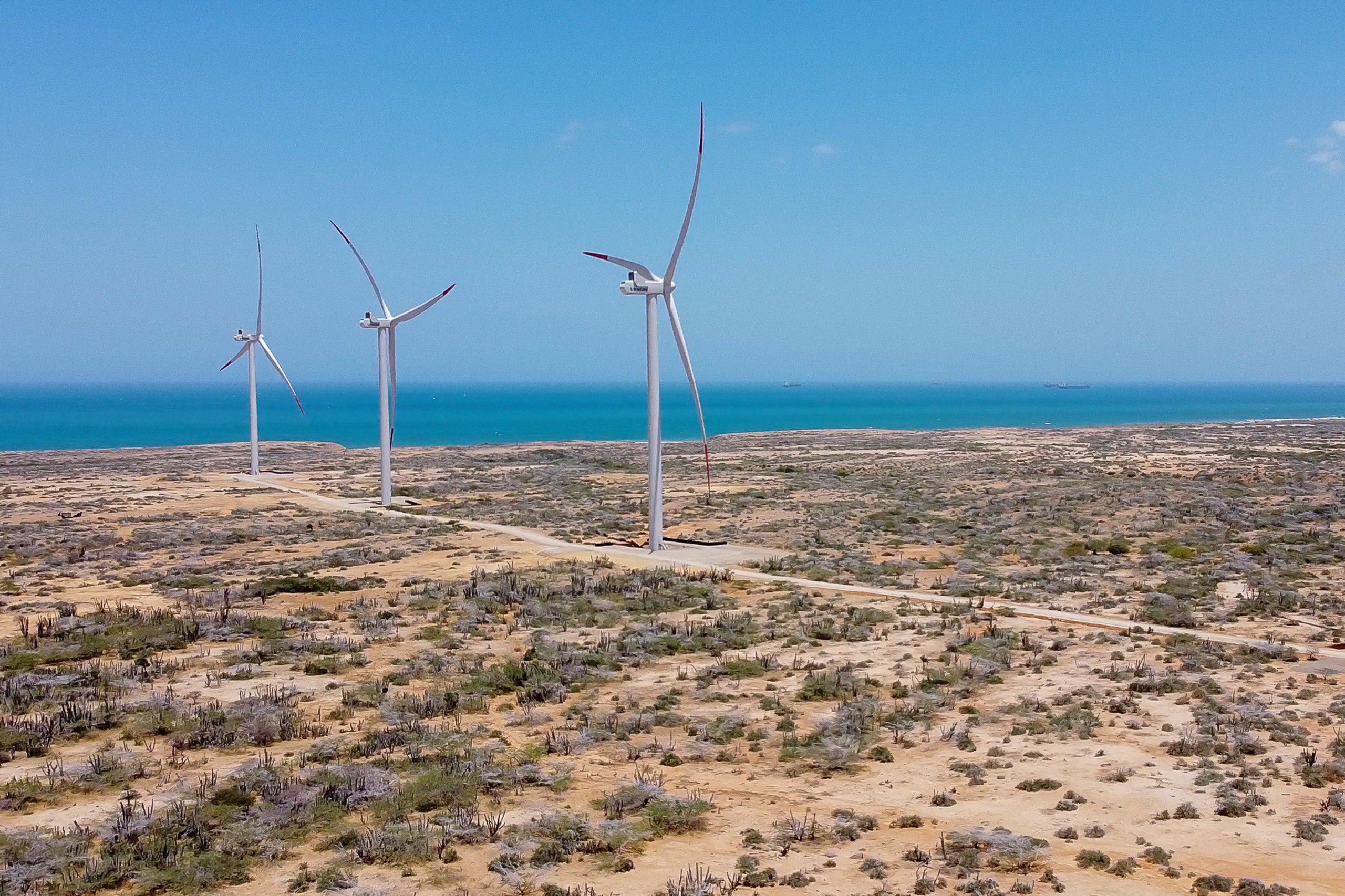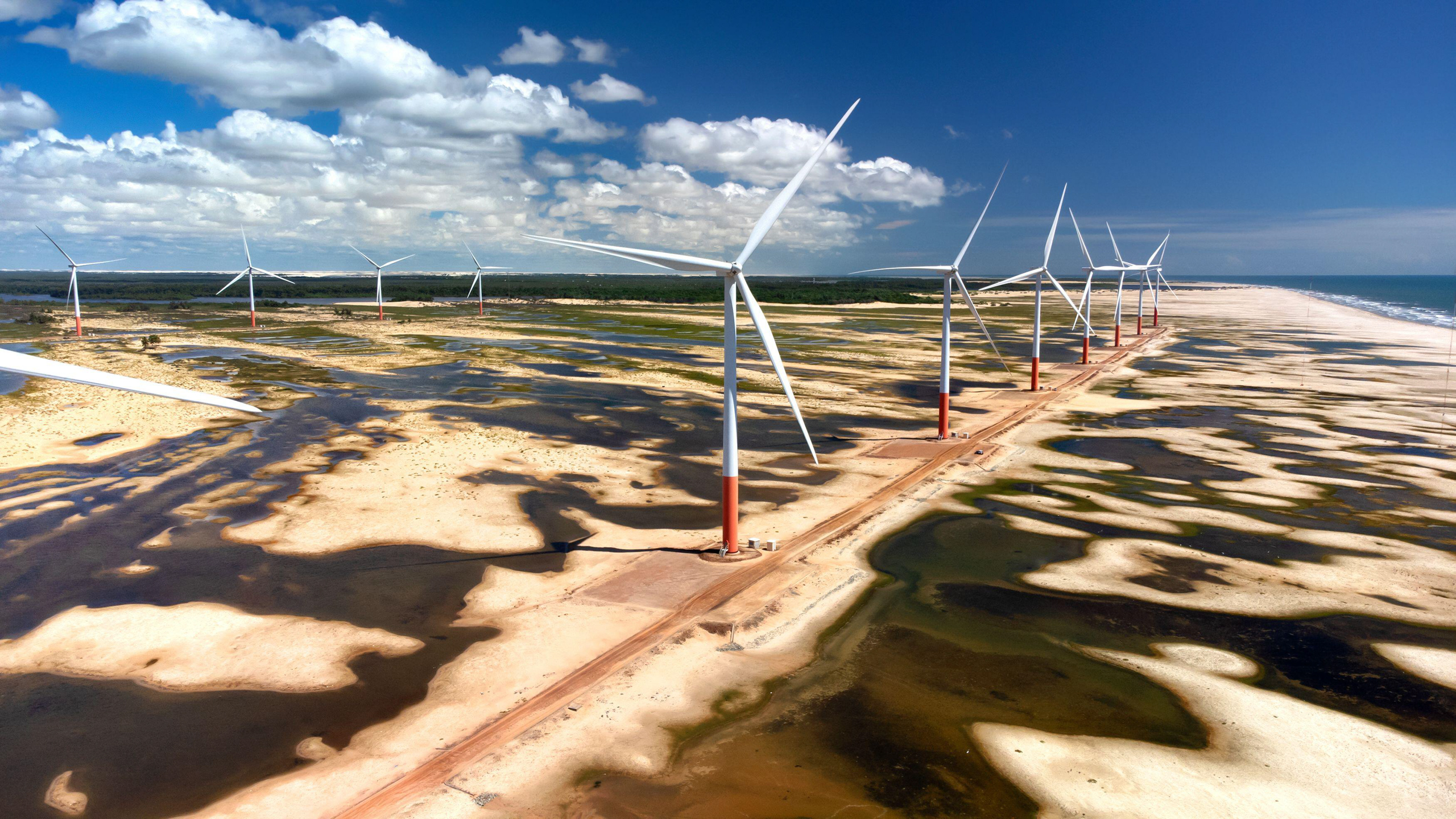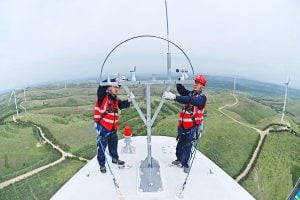The development of offshore wind energy is entering a defining moment in Latin America, following years of expectation that have raised hopes for the energy source, but which have yet to result in a single turbine operating off the region’s coast.
This August, Brazil’s senate plans to vote on a regulatory framework for offshore wind that will be essential for the sector to advance, while Colombia is expecting bids by September from companies wanting to explore its maritime area.
Experts say that expanding offshore wind energy could help to reduce the use of fossil fuels and even boost jobs and local economies, since this will require both the construction of offshore wind farms and the modernisation of land-based infrastructure such as ports.
In countries that are expanding their offshore wind sector, investments can be “huge levers for economic and industrial development”, Ramón Fiestas, director for Latin America at the Global Wind Energy Council, told Dialogue Earth.
However, the level of investment that the sector requires is very high. According to a survey by the Brazilian Infrastructure Centre (CBIE), a consultancy, due to the costs of construction at sea, offshore wind energy’s cost per megawatt can be three times more expensive than that of onshore wind facilities. If the costs of new underwater transmission lines are taken into account, the figure is multiplied tenfold.
In addition, experts say there is a lack of locally relevant evidence on the socio-environmental risks of offshore wind farms. “There is no study on the impacts of these projects in the southern hemisphere,” said Adryane Gorayeb, coordinator of the Wind Energy Observatory at the Federal University of Ceará, in Brazil’s north-east. Gorayeb points out that studies on the Latin American coast are generally scarce, “both in geophysical, biological, ecological and social terms”, which raises concerns about the possible marine impacts of developing offshore energy infrastructure.
Brazil’s offshore potential
At sea, winds are more constant and intense than on land, and the area is wider for wind farms, providing greater potential for energy generation. “This is enormously valuable for an electricity system,” said Fiestas.
Brazil is already the largest producer of onshore wind energy in Latin America, and has the technical potential to generate more than 1,200 gigawatts (GW) of offshore energy, according to a World Bank report published in July. This would represent a significant expansion of the country’s total installed capacity across all electricity sources, which surpassed 200 GW in July. The document also states that the sector could generate 516,000 jobs by 2050, bringing at least USD 168 billion to the Brazilian economy.
Brazil’s offshore wind potential is “vigorous, consistent, geographically diverse, and located close to demand centres”, the report notes. With this, “offshore wind could figure prominently in the country’s long-term energy mix”, its authors add.
This has attracted many interested parties. As of April, there had been 97 applications for offshore wind project licences filed with Ibama, the Brazilian government’s environmental agency, which opened a registry even before a regulatory framework for the sector has been enacted.
According to Ibama data, most of the proposed projects are located in Brazil’s southernmost state, Rio Grande do Sul (27), and Ceará (25) in the north-east, positioned between 10 and 40 kilometres from the shore. An installed capacity of 234 GW is expected with all projects proposed in the country.
Data from the agency shows that requests have accelerated since 2022, when a decree was issued regulating the transfer of marine areas from the government to the sector. But the establishment of the regulatory framework remains a key hurdle.
“The first step is to have a legal framework. Without it, nothing will happen, because the sea is a federal asset,” said Elbia Gannoum, president of the Brazilian Wind Energy Association (Abeeólica), which brings together more than 150 companies active in the sector.
The bill for this framework was set to be voted on this August by the senate, although political impasses are hindering its progress. It has been approved by the House of Representatives, the lower house of parliament, in November 2023. Gannoum estimates that, if it is approved this year, this would allow areas to be auctioned off in 2025, licences to be granted in 2028 and power plants to begin operating between 2031 and 2032.
Its approval is considered a priority by the federal government and is part of a package of measures linked to the energy transition – including the legal framework for green hydrogen, which came into force at the beginning of August.
“Brazil has great potential to produce cheap green hydrogen, and offshore wind energy will contribute significantly to this,” said Gannoum. “We see this as an opportunity to industrialise the economy from a renewable energy matrix.”
Colombian offshore auctions
Home to a vast coastline stretching more than 3,000 kilometres, Colombia has been looking to accelerate its offshore wind sector since 2022, having approved an action plan and a resolution setting out guidelines for auctions.
Unlike Brazil, Colombia is not seeking to pass a specific law to regulate offshore wind companies and is relying on existing electricity generation regulations. But this regulatory gap could present risks, aggravated by an institutional crisis. Legal guidelines dictate that the country’s president has a responsibility to appoint six full-time experts to support the Energy and Gas Regulation Commission (CREG), but this agency recently spent almost a year with only provisional experts in position, and today has only one appointed official and three serving in a temporary capacity.
“These [offshore] projects are long-term, requiring clear rules so that investors can make their investments,” said Santiago Arango, an energy researcher and professor at the Faculty of Mines of the National University of Colombia in Medellín.
In October 2023, the Colombian government launched Latin America’s first auction for offshore wind projects, the deadline for which has been extended to this September. Interested parties will compete for temporary eight-year licences to assess the viability of the offshore areas. The contracts can then be converted into concessions to build and operate offshore wind farms for up to 30 years, with an optional 15-year extension.
The winners should be chosen by August 2025, and the licences are expected to be granted in December of the same year.
Colombia has a total installed capacity across all electricity sources of 20 GW, with targets set for offshore wind capacity of 7 GW by 2040 and 13 GW by 2050. According to the action plan, its technical potential for the energy source is between 50 GW and 100 GW.
But not everyone has confidence in this progress. “These are extremely ambitious targets,” said Arango. “I doubt they will be achieved.”
Other Latin American countries are also investing in the sector, but in a more nascent way. In March, the Chilean government announced the development of its action plan, and in August, a British-Chilean consortium expressed interest in building an offshore wind farm in the country. Uruguay, meanwhile, launched a plan for the sector in 2022 and is expected to announce a call for investors later this year.
Socio-environmental challenges ahead
Despite high ambitions and expectations for the offshore wind sector, Adryane Gorayeb and other experts warn that if studies are rushed through in order to speed up the installation of projects, this could destroy marine ecosystems, damaging fishing, tourism and shipping.
Gorayeb cites possible impacts on marine biodiversity and ocean currents from construction and other operations of offshore wind companies. There are also possible knock-on environmental effects along the supply chain to consider, for example, in the extraction of wood for the construction of turbines.
Communities are beginning to fear the changes that these projects could bring to their territory, such as property speculation and price increasesAdryane Gorayeb, coordinator of the Wind Energy Observatory at the Federal University of Ceará
The installation of the turbines could be a concern for coastal populations, Gorayeb added. “Communities are beginning to fear the changes that these projects could bring to their territory, such as property speculation and price increases,” she said.
In Colombia, of particular concern is Alta Guajira. This northern region has been eyed by the wind sector, and targeted by the government as the “epicentre” of the country’s energy transition, but is also home to many Indigenous communities.
“It’s important to carry out good social management of these projects, going beyond the prior consultations required by law,” said Santiago Arango.
With regard to such concerns in Brazil, Elbia Gannoum, from Abeeólica, suggested that the licensing process will be sufficient to avoid any harmful impacts.
“Once the holder has the title, they will conduct the necessary studies and, based on them, request authorisation from Ibama,” she said. “The studies include assessing the marine population, fishers’ activities and oil impacts.”
Ramón Fiestas, from GWEC, said there is a lot of accumulated experience around offshore technology, and international best practices back it up.
“Between the fishing communities and those responsible for the projects, links are generally created and problems are resolved, usually by delimiting the fishing areas that are compatible with the existence of the wind turbines,” he said.
However, the record to date of onshore wind farms across Latin America, including in Brazil, Colombia and Mexico, has suggested that licensing and accumulated experience have not always been enough to avoid damaging impacts on biodiversity and communities.
Infrastructure and lobbies
Another source of uncertainty surrounding Latin American countries’ moves into the offshore wind sector highlighted by experts is the current capacity to integrate facilities into their energy systems. According to Fiestas, until mature infrastructure is in place, offshore wind requires large-scale construction, usually of farms with an installed capacity of over 500 MW.
“It’s on this scale that you can find synergies and economies of scale, especially in costs, and also rationalise the supply chain,” said Fiestas.
But this scale would be more difficult to achieve in small countries in the region, where each project can significantly increase its electricity generation capacity.
Fiestas cited the example of Uruguay, where the installed capacity of all electricity sources was 5.3 GW in 2022. Developing a 1 GW project would represent around 20% of its electricity system. “In a small country like Uruguay, a large project like … offshore wind energy can represent a huge technological challenge,” he added.
Finally, there are political impasses. Offshore wind power is being resisted by sectors linked to fossil fuels. In Brazil, when the country’s bill on the sector passed through the lower house of congress, it featured incentives to benefit thermoelectric plants – an inclusion that stalled the vote, which has not been agreed upon yet.
The resistance of these sectors and the preference for cheaper and more familiar energy production options could be repeated in other countries. In March, during a drought caused by the El Niño phenomenon, Colombia maximised the output of its thermoelectric plants.
Despite speeches in favour of the energy transition, governments can be hesitant in the face of high investments and risk of blackouts that often affect countries in the region, such as Venezuela, Chile and Ecuador.
“Governments often make a speech, but when it comes down to it, they need to have security,” said Santiago Arango. “No government wants to pay the political cost of having a country blacked out, so there could be a conflict with the predominant role of fossil fuels.”










